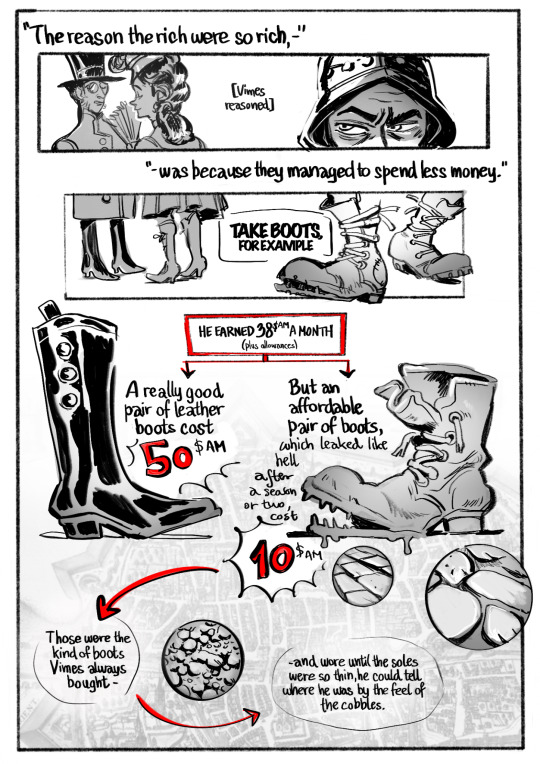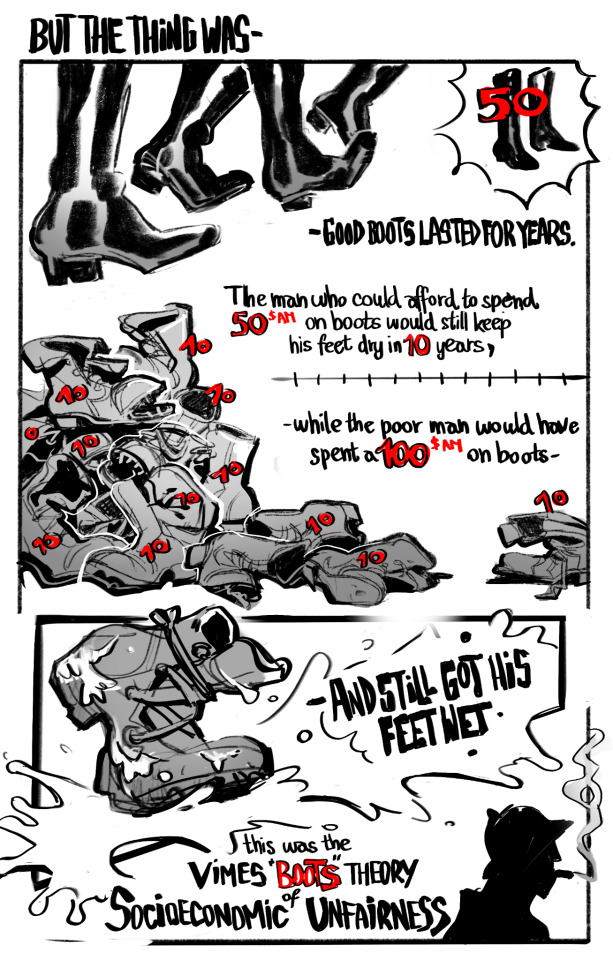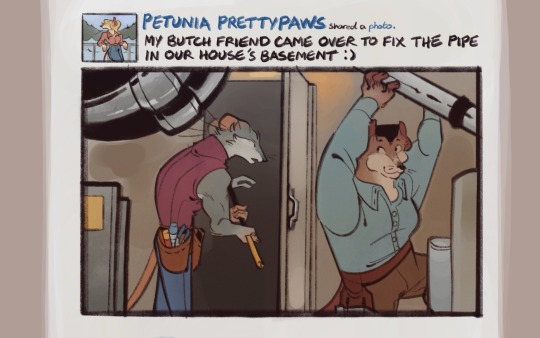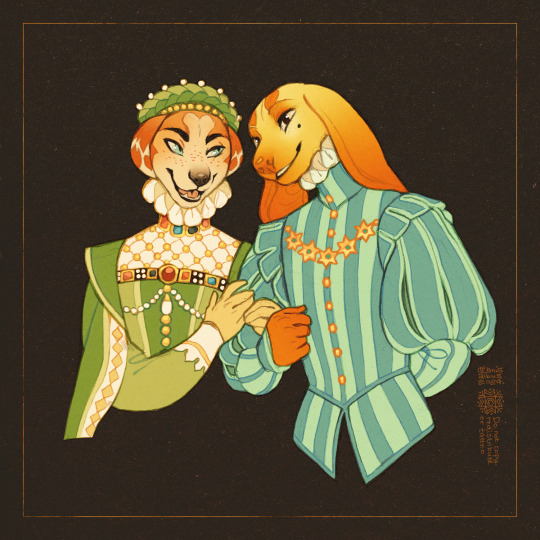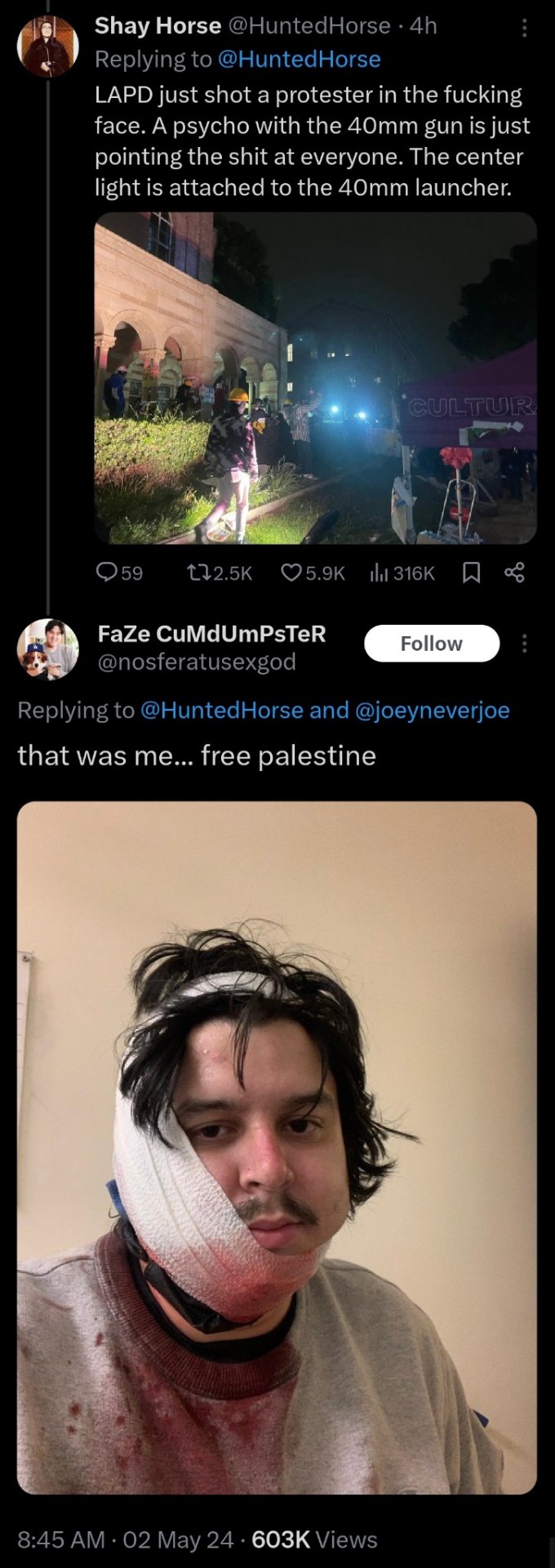Photo
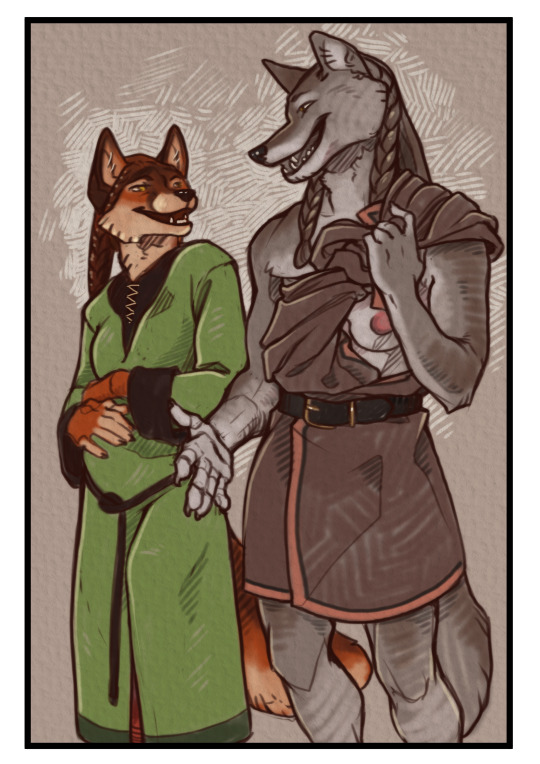
Gilliflowers: Western Ki
Posted to SubscribeStar: 02/02/2024 The native Britons are Western Ki, they were primarily wolf-kind in the North and East, but fox-kind in the West and South, where the two -kinds meet the differences are far less obvious. The wolf-kind societies in the north tended towards a greater propensity towards aggression, and those in the south towards defensive aspects, but both groups have their fair share of warfare in their histories. The Britons all tended towards smaller communities, in the north these tribal communities were heavily defined, and right up to the modern day the associated tribal tartans survived, more or less. In Kernow this tendency towards smaller groups continued far longer, with Kernow being among the last places in the British isles to adopt towns, and the native population being incredibly distrustful of the deliberately built towns. Post-Event the native (or at least local) Ki population were among the first to retrench back to their traditional hamlets in Kernow, this tendency meant they were among the first to re-colonize the nation after the Wild took over, the hamlets were small and inobtrusive enough that even during the early years of increased hostility, they were mostly left alone. As the hostility reduced, the hamlets became important way points as roads were reopened, with travel becoming slower and more arduous, being able to move from hamlet to farm to village to lonely house on the moor became increasingly important. Ki continue to be among the most likely people to live inland in Kernow, with a closer relationship with Sabers than the coastal and town dwelling people. They provide the highest number of druids to the Wild and pioneered the sun-worship revival that overtook the traditional Kathden Trinitarianism. Pellars are disproportionately Ki. Clothing note: while tartan remained a singularly Scottish invention, later 'Welsh' and 'Cornish' etc... Tartans arose in modern times, the kilt and its various forms, was adopted more widely in this alternate world, with it being such a sensible piece of clothing for an anthropomorphic people, it survived, even as other forms of clothing came in and out of style.
Posted using PostyBirb
7 notes
·
View notes
Photo

Gilliflowers: Ki Women
Posted to SubscribeStar: 20/01/2024 I still have a lot of work to do in refining the Ki, both socially and in terms of apperance, they mostly vary from being very wolf-like to like traditional guardian 'breeds' (in the real world) depending on how large and complex their societies got, but they never reached the level of variety that dogs in the real world have got to through selective breeding. Wolf-like Ki tend towards smaller more ancient social groups and are flighty, not thriving in larger modern settings, and struggling pre-event to maintain their life styles in the face of 'progress', post-event, like the Sabres, they've been able to carve out their own spaces with greater success, but maintain a flighty where the Sabres are more confident. The specific roles Ki women have taken in society have varied a lot across cultures and eras, however a good rule of thumb is that women have been both politically dominant and the leaders of the family. Social structures are built around reproduction and child rearing, and often care for the elderly and infirm, this has generally lead to more accessible cultures, with disabled, young and elderly members being more valued and having important roles within the family/wider society, while the able hunt, farm etc... Where groups of Ki are small, they are usually headed by one or two women who lead and maintain a preferred harem of males, breeding restrictions or permissibility have varied a lot, sometimes only the lead female is allowed to have children, in others the lead female is considered to already be the mother of all others and does not breed, the leader role is usually comparatively short lived with an expectation that one will eventually attend to her own immediate family and pass on the torch at some point, her knowledge and expertise continuing to be available to the next leader. Larger groups have more complicated hierarchies and politics, but maintain the small-tribe structure on the family level, with a matriarch and her family. Typically the matriarch is the primary breeding female in the family (priority being given to whomever starts their family first, rather than age, though there is a close correlation). Mothers, grandmothers, aunts and daughters are well known to collaborate on evaluating males as potential partners, and courting a woman can be an intimidating past time if her family are hard to impress.
Posted using PostyBirb
2 notes
·
View notes
Photo

Gilliflowers: Outside the Binary
Posted to SubscribeStar: 26/01/2024 The roles of trans people (or their historical counter parts) is fairly long even when summerised, and I hesistated to post it all here, but ya know what, I started this friday tradition for that very reason so here you go... But I will post the case studies first.
Gene
A trans woman on HRT, Gene is particular about keeping her stock available. Generally comfortable in her own identity as long as she can self regulate, she presents quite masculine and shrugs off genuine mistakes very easily, but has no qualms standing up for herself against people deliberately misgendering her. Her partner is a cis woman and is putting a lot of pressure on her to sire pups through her, which Gene is very reluctant to do, her comfort around sex is declining and she struggled to see herself as a mother or woman if she's sired pups, she also has deep rooted fears over being a bad mother. This is both generally cultural and has its roots in her parents, whose failure to accept her as a woman drove her to run away from home as a teenager. Gene has remained quite isolated from other Ki socially, and her closest relationship outside of her partner is with Mil. Generally she prefers to be alone, but struggles with loneliness, particularly coming from a society with such strong emphasis on extended family units.
Mil
Mil, a trans man on inconsistent HRT, benefits from his sabre inheritance and was already a large fairly androgynous person even before his transition. He struggles with a desire to sire cubs that he can't satisfy, which impacts his confidence in courting Chelsea, with her religious and cultural expectations. Mil has had two children himself, a fact he keeps quiet, he is in contact with one of his children but not the other. His regrets over being so distant from his children, the fact he didn't resent pregnancy and his enjoyment of penetrative sex bother him, clashing with his mental image of himself as a male Kathden, he dabbled history when he was younger, taking comfort in the complex roles of sub-males within prides who often crouched for the breeding males, while having access to their own harems, but the lion-mythos fetish turned him off and it's been a while since he dwelt on the topic. Mil's relationships have been few and far between, and he isn't particularly inclined to pursue a long term partner/s. Despite this he has had casual relationships with people who've already proven themselves to him, notably the sabre adopted parents of his second child. He is more inclined towards sabres due to their already fairly egalitarian and androgyne styles.
Trans people (and their equivalents in time) in Ki and Kathden society have played a number of roles since the start of recorded history, and how they've been accepted by their communities has varied widely from place to place. Ki trans people have commonly been accepted in their gender roles as part of the standard in their societies, however their relationships, status and roles have been prone to change according to how they've conformed to gender norms, having children, while not usually technically barred to them, has often been culturally stigmatised, however there have been some notable matriarchs who particularly valued trans women as their consorts. Trans men in Ki society were generally ignored as part of the men folk, unless they got pregnant, which often forced them one way or another back into the role of woman. In pre-event modern Ki society, with matriarchs being limited to the heads of family groups, the pressure on trans people has reduced, and they are usually equal members of their family group or local community, in line with their gender role. It is highly unusual but not impossible to see trans women in the role of matriarch however, due to the expectation of lineage through the mother's line, and how the position is inherited. Legally the Ki are no longer tied to a matrilineal system, but culturally it is still widely practiced, leaving trans people in a cultural grey area in terms of inheritance. Post-event things remained very similar, but for a time things did shift back to the older way of re-assigning gender according to events in a person's life. Childbirth and rearing is a huge stumbling block for many trans people. Generally trans women maintain their gender role irrespective of who bore their children, as long as they play the mother role, but it can often be a struggle for the woman in question to be allowed to play that role in a social setting. Once her foot is in the door however, she'll usually be accepted, if her children are adopted or sired through a donor (cis) male through her partner, she will have better luck, as these are considered already perfectly acceptable ways for a cis woman to have children. Some families/groups however will insist that a trans woman who sired her own pups is playing the role of a man and should live as such, effectively barring them from (bio) motherhood. Trans men had similar issues, while the inability to get pregnant or bear children is not considered a block to womanhood, getting pregnant/birth is so intrinsically linked to womanhood in Ki society that the idea of someone maintaining man-hood while bearing children is almost impossible to balance in the Ki mind, and just about any Ki trans man would find himself immediately expected to live as a woman if he found himself in that situation. This became less common as one moves towards the modern era, but in general Ki trans men are highly unlikely to voluntarily have children. Historically there have been a few matriarchs to appear to have actually been trans men, and walked a narrow line where their power allowed them to restructure the expectations around their gender. When the matrilinial laws were still in place, trans women were unable to pass on their family line to any child they sired biologically, only being able if their child was adopted into their family and they were seen to have played the mother role, if their partner was a cis woman, she got the right to pass on her line above her trans partner however. The details of this varied from culture to culture, but generally trans women either couldn't pass on the family name or had second priority. Trans men couldn't pass on their line if they were still seen in their culture as men, but may be forced to if their partner was a cis man, or they bore the child/ren themselves. Pre-event medica l transition was widely available, both in terms of HRT and operations, for the Ki, who have greater dimorphism, there was greater pressure to medically transition, bottom surgery was also often used to 'lock in' ones transition, at the cost of fertility, as it blocked any accusation of having had pups, or the possibility of doing so in the future, outside of their gender role. Kathden trans people have a very different background, as a species with a long history of prides of females lead by a single male and later polygamy. Trans women in pridal society might not get the chance to integrate as women, if that was even a possibility, if they were chased out of their pride before they transitioned. For those who could stay with their pride if they continued to live as women, castration was incredibly common. In some areas they were considered a 3rd gender, of which there were a few variations. In some places they were effectively seen as women-pleasers-of-women. More common in very large prides or prides that had to be more cautious of their growth, they were allowed to live as women alongside the women, with the expectation that they were Also playing a sub-male role, unable to reproduce, they were allowed to mate with the women when they were in heat with impunity. In other areas this 3rd gender was made available to non-breeding males, brothers, uncles etc... who the pride leader allowed to remain, they were barred from mating with the cis women, but had their own harem of the 3rd gender trans women. Less commonly they appear to have become a part of a gender role limited to All infertile kathden within a tribe, that had specific religious and spiritual roles. Trans male kathden didn't have as many options, and were usually treated the same as any woman in the pride, many would leave and attempt to live as bachelors, but this put them at risk of other bachelors who might see them as lone females. As one moves towards the modern era and the pride structure gave way to larger communities of family groups, trans men started to have a better lot in life. The 3rd gender became more fragmented and less relevant. One thing remained incredibly important, even up to post-even times. Kathden men continue to have a lot of social pressure on them to demonstrate their virility by siring children, while simultaneously carrying children and raising them is seen as a very feminine role (note: historically the pride lead male would keep an eye on the children when the women were working, this role was lost as communities got more complex), trans men are left in the cold, there is a lot of shame associated with having had children, but also with not having had children, it tends to be the biggest breaking point for kathden families when bio children come into question. Trans women come under less scrutiny in this regard, as there is an unspoken expectation that they will want children as women, and won't care how that child arrives, so while there may be some ribbing regarding virility if a trans woman has a larger number of children, it's usually not considered a mark against her feminity, as all women are expected to have multiple children with their partners anyway. Trans women often played an important role in childrearing as the responsibility fell away from the males, as they often didn't contribute to the over all number of children, but were able to raise them. This appears to have been adopted early on in prides were the 3rd gender role was taken up by the non-breeding male's partners, who often were not expected to hunt and work, only raise the breeding-male's children (this doubled as a way of reminding the non-breeding males of their place in the pride). Post-event operations are comparatively inaccessible, but HRT remains available. There is very low expectation for trans people to have bottom surgery, top surgery requires access to the larger cities and HRT access is often inconsistent away from the cities.
Posted using PostyBirb
2 notes
·
View notes
Photo

Gilliflowers: Future of The Pride
Originally Posted to my Subscribe Star Dec '23 A kathden mother and her son, unaware of how they're changing the path of their people forever. The other women of her pride think she's both unlucky and slightly mad, she has only ever had sons and so lives alone, but unlike the other boys she keeps her sons with her during the day, not just when hunting and butchering, but also cooking, sewing, making pots, and setting fires, her whole day she has them trotting at her heels, learning women's ways. Their king lets it go as she doesn't put up a fight when her sons are of age and must leave, and that's really all he cares about. All over the world there are women like her, not many, but a few, outliers, slightly mad sending feminine boys out into the wild to forge their own way. They, like her, have no idea how well they've set up their sons for success, how, on average, more of them will survive, able to cook better, store better, build and protect themselves better, not just hunt, not just fight. They will win their own prides, some small, some large, and some will succeed in changing the minds of the women who live under them, and their sons will do better too. This mother and her son don't know and will never appreciate their role in changing the path of their people in the south, always successful, they are about to take a huge step forwards towards larger more complex groups and cooperation. A few hundred years later and boys will no longer be driven away, prides will become collections of family groups and what will become known as the 'modern era' will begin for the kathden.
Posted using PostyBirb
#cornish artist#fantasy art#digital art#artists on tumblr#tumblr artists#my art#gilliflowers#feline#mother#son#sfw#pottery
2 notes
·
View notes
Text
the fact that we made it through the Cold War is nothing short of a miracle. I wish we talked about Mutual Assured Destruction more in schools
46K notes
·
View notes
Text
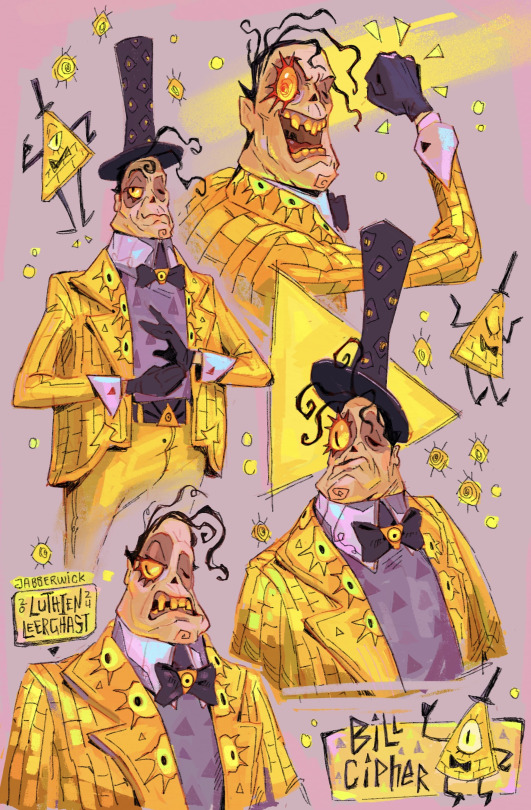
Human Bill Cipher
(Based on Alex Hirsch's "canon" design)
And just to be clear, writing dissertations at me justifying why he should instead be a conventionally attractive twink will involuntarily cause me to draw him with even fewer teeth.
27K notes
·
View notes
Text
it's hard to not be frustrated that people have mostly settled on "drawing for yourself" in response to the deep sense of loss and frustration at any and all art related jobs basically going extinct overnight. I don't think personal work and the work you do in the context of a larger project are even remotely similar on any tangible level
770 notes
·
View notes
Text
Eurovision is the absolute easiest thing in the world to boycott. It's not food owned by one of 5 food conglomerates. It's not tech that corporations have made essential. There's no "support the devs" logic to be even considered. It's literally just noise that is forgotten in a week.
This year it's noise that will be forgotten in a week that is actively supporting one state that's committing genocide to another state they're actively suppressing any discussion about.
27K notes
·
View notes
Text
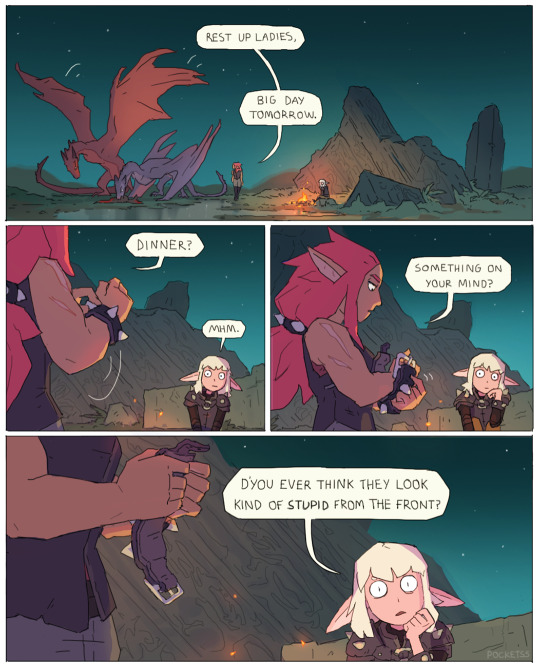

the girls...
108K notes
·
View notes
Text
"I keep running into cats that shouldn't be allowed to roam free"
That's all of them for those not paying attention.
Cats are written into UK law as "free spirits" so they're exempt from owners getting held accountable for letting them wander and it makes me so feral.
Thankfully she's gone now but we just had a neighbour with SIX wandering cats, all of which had chronic shits, presumably she was unaware because they were all too busy leaving runny craps all over my garden. So much of my gardening experience involves growing spiny plants to lay as deterrents because Guess What Doesn't Work In Places With A Lot of Rain!? Most deterrents.
I'm looking at some of the better sonic deterrents but they're £70 EACH and I'll probably need four to cover the garden effectively. Like god damn it I have more important things I need to spend my money on, than Your Cat.
All I want is to be able to watch the birds without having to sprint outside to chase a cat or go enjoy the sun without smelling cat shit (not to mention wanting to Eat some of my plants).
And the thing is I Like cats.
I don't want your pet limping home from jumping on gorse or roses hidden in the grass or on the fence or panicking and throwing itself up a sheer wall when I come out. I want it Fucking Taken Care Off Like Everything Else Is Expected To Be.
Does it seem weird that people treat cats like they’re wild animals to anyone else? And by that I don’t mean people expect cats to survive on their own in the wild. I mean people act like pet cats who have owners are wild animals that the owners aren’t responsible for. And I’m not talking about cat owners specifically. A lot of people who doesn’t have any pets at all act like cats are wild animals (which might be why so many people treat them like wild animals that can be hurt with no consequences)
I never thought about that until a few years ago when someone in the town Facebook group asked who owned a cat that kept jumping in through his windows. It was summer so he couldn’t keep his windows closed (we don’t use air conditioning in this country) and he had a terrible allergy to cats so it was legit dangerous for him to have a cat running around his house.
People started offering solutions like “buy this spray that deters cats” and “you can buy this rolling thing for the top of your fence” but his response was “Okay but why am I expected to spend all this money to keep someone’s pet out? Who owns this cat!?” When he didn’t get an answer he eventually got a friend to pick the cat up when it was in his house and he drove it to a shelter, and informed the Facebook group which shelter. Suddenly the owner responded, angry that he’d do such a thing! Getting the cat back would cost money! But the guy was like where the fuck were you when I asked who the cat belonged to!? I was trying to avoid this!
I was honestly surprised by how many people were on the side of the cat’s owner. Another cat owner on our street isn’t responsible enough to keep her cat indoors but responsible enough to at least buy stuff for other people if her cats bother them. She practically have a small stach of cat deterrent spray she hands out to the neighbors who doesn’t want cats in their garden.
The whole thing really made me realize how strange it is that cats are the only pets where we expect other people to spend their money on building fences to keep them out instead of the owners trying to keep them in, as if they were wild animals with no owner to look after them.
9K notes
·
View notes
Text

more art of bella & prue, the lesbian protagonists of our original graphic novel set in regency england >:3c 💗💜
391 notes
·
View notes
Text

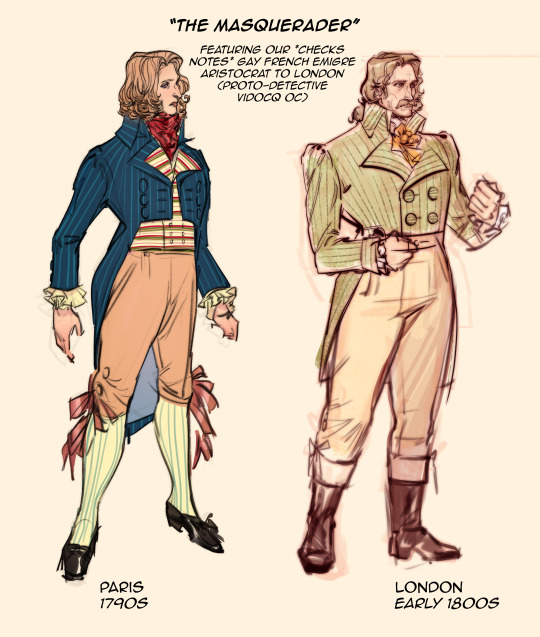
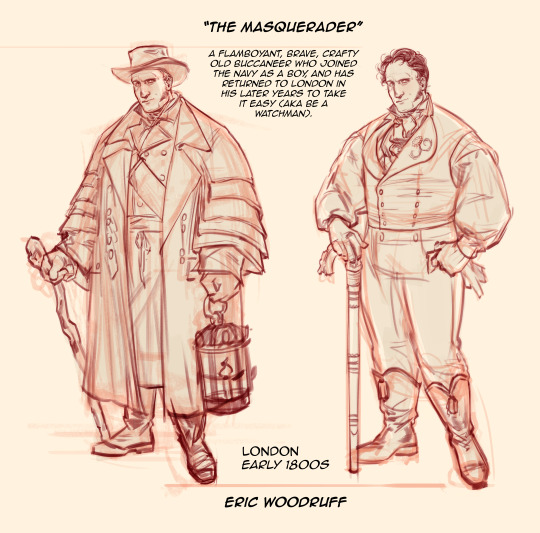
they're regency boyfriends who met in paris in their 20s in the 1790s 🥺
The Masquerader, a queer Regency webcomic
2K notes
·
View notes
Text
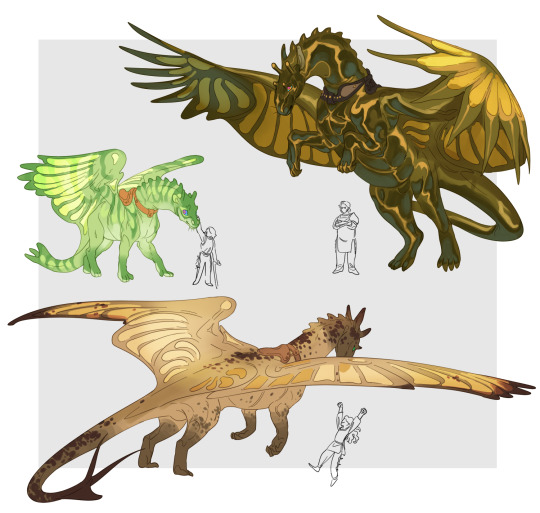
hits u with my dragon beam
tha boys and their dragons from the au i am self-indulgently messing with. green, bronze, and brown. these are scaled to their actual sizes relative to one another & their riders.
reasoning/more info under the cut. when i say 'niche audience' i mean the approximately One Person who knows my characters and has also read a pern book (me. i'm the one person it's me)
Féiix is a green rider obvs. I think it's really generous of dragons to have a colour specifically for bottoms. Her name is Searrath and she ends up committing matricide by stubbornly rising at the same time as queen Lenath, to protest the weyrwoman's abusive treatment of her rider. Searrath is legendarily short-tempered and protective, and although her rider might continually reassure her that his arrangement with the weyrwoman (as her personal spy; he is an ex-harper) is healthy, Searrath has other ideas. She is quite good at precise hops between, which is how she manages to bait Lenath into flying head first into a mountainside.
Islin's bronze Taranth is very big, very gentle, and completely unwilling to do his duty as a bronze in any capacity at all. He has a... complicated relationship with Lenath and endures a good amount of ridicule, but Islin is adamant that he will never make a bid for weyrleader as this involves sleeping with the weyrwoman and queen (he'll settle for being wingleader). A strong disagreement over Félix's spywork and loyalty to Lenath leads Islin and Taranth to walk out from their weyr, and operate out of a different base for years before Lenath ultimately dies from failing to compete with Searrath on a mating flight. He is the only bronze rider who is not originally from a weyr.
Francis's brown Nelath was almost killed by Lenath when he hatched. As the son of the newly-ousted ex-weyrleader, Francis could have easily impressed a bronze and ousted the current weyrleader, so the weyrwoman conspired to prevent it from happening. Lenath broke Nelath's leg during the hatching, and only the invervention of Francis's father's bronze saved both himself and the injured hatchling from what appeared to be the queen's random fit of infanticidal rage. Nelath recovered well and became a very popular brown dragon and an impressively good shot with his flames. He has attempted several times to chase a queen (usually one of the juniors, still a little wary of Lenath), and has even succeeded more than once. Francis and Nelath support one of those junior queens during an attempted ousting of Lenath and the weyrwoman, but never expected that Félix's loyalty to the weyrwoman would separate them for years (until Lenath goes out carcrash style against a mountainside, as previously mentioned)
It's my first time trying to write a full conspiracy over the course of the characters' lifetimes so it's pretty fun!
387 notes
·
View notes
